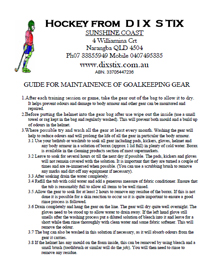Here are some great tips and advice on how to keep your kit in its best condition.
1.After each training session or game, take the gear out of the bag to allow it to dry. It helps prevent odours and damage to body armour and other gear can be monitored and repaired.
2.Before putting the helmet into the gear bag after use wipe out the inside (use a small towel or rag kept in the bag and regularly washed). This will prevent both mould and a build up of odours in the helmet.
3.Where possible try and wash all the gear at least every month. Washing the gear will help to reduce odours and will prolong the life of all the gear in particular the body armour.
3.1 Use your bathtub or washtub to soak all gear including pads, kickers, gloves, helmet and any body armour in a solution of borax (approx 1 lid full) in plenty of cold water. Borax is available in the cleaning products section of most supermarkets.
3.2 Leave to soak for several hours or till the next day if possible. The pads, kickers and gloves will not remain covered with the solution. It is important that they are turned a couple of times and are re-immersed when possible. (You can use a scrubbing brush to remove any marks and dirt off any equipment if necessary).
3.3 After soaking drain the water completely.
3.4 Refill the tub with cold water and add a generous measure of fabric conditioner. Ensure that the tub is reasonably full to allow all items to be well rinsed.
3.5 Allow the gear to soak for at least 2 hours to remove any residue of the borax. If this is not done it is possible for a skin reaction to occur so it is quite important to ensure a good rinse process is followed.
3.6 Drain completely and hang the gear on the line. The gear will dry quite well overnight. The gloves need to be stood up to allow water to drain away. If the left hand glove still smells after the washing process put a diluted solution of bleach into it and leave for a short while then rinse thoroughly with clean water and some fabric softener. This will remove the odour.
3.7 The bag can also be washed in this solution if necessary, as it will absorb odours from the gear it carries.
3.8 If the helmet has any mould on the foam inside, this can be removed by using bleach and a small brush (toothbrush or similar will do the job). You will then need to rinse to remove any residue.
4.When the gear is dry, check all the gear for any damage that needs repairing.
4.1 Look for any areas of separation on the pads and kickers, which may need reglueing. This includes any tears or splits. Reglue as necessary using contact adhesive or shoe goo.
4.2 Check kicker and pad straps and if necessary, replace prior to them breaking and being a problem. It is likely that the kicker straps will break more often that the pad straps. Checking for wear and early replacement can prevent these problems from occurring. Look for any padding in the helmet, which may be loose and need reglueing. Check any straps and other replaceable items such as chinstraps are in good order. Repair and replace as necessary.
4.3 Check all the screws on the helmet and tighten any that may be loose. You may need to do this on a weekly basis. It can be useful to carry a couple of short handled screwdrivers in the gear bag to manage this process. If any screws or other pieces have been lost, replacement kits can be purchased. Also check for any splits or cracks to ensure that the helmet continues to meet the safety standards required.
4.4 Check body armour for any wear. If necessary repair any small tears and broken seams with a large needle and strong thread. Any major damage can be repaired by a saddler or a shoe repair company. If maintenance and checking of body armour is carried out on a regular basis, this allows repairs to be made quickly with minimal disruption to training and games.
4.5 Check the bag for any damage, which can be repaired. A saddler or shoe repair company can repair damage.
5. To assist with odours emanating from the gear and bag whilst in the car, a can of Glen20 kept in the bag and sprayed in the car and gear bag can temporarily neutralise the odours. However, keeping the gear reasonably clean and dry can help prevent any problems with odour. DO NOT USE DE-ODOURANTS AS THEY ATTACK THE FOAM If you are not leaving the playing fields straight away it may be helpful to leave the gear out to dry a bit before packing up.
6. It is in your interests to keep the gear well maintained and clean as it will last longer and will therefore not be a financial drain. If the steps listed above are adhered to any replacements or repairs due to wear and tear can be carried out quickly to minimise any disruption to you, your team, coach or club. Any repairs should be carried out as quickly as possible to ensure that gear is always ready for use.
7. It is imperative that you check your gear at the completion of the season to ensure that your gear will be in good playing order at the beginning of the next season. You will also be able to organise the purchase of new gear, which will reduce any extra costs to start the next season. This will also enable you to wear any new gear in prior to the start of the next season.

Download the PDF
Thanks to Animal who supplied the PDF and wrote the content.




